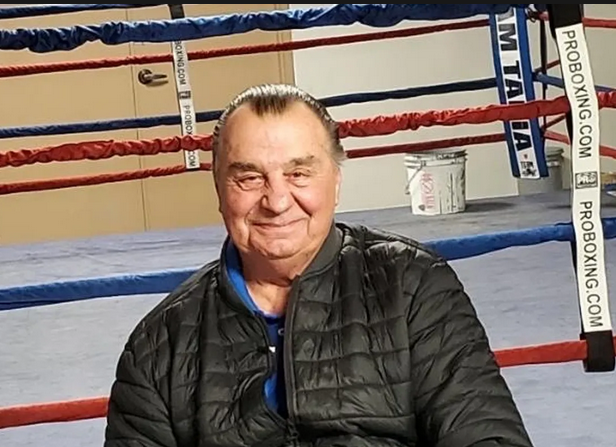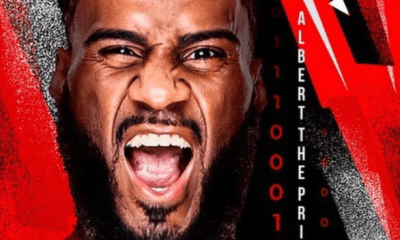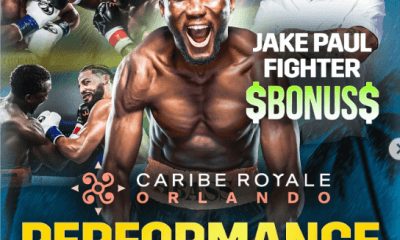Featured Articles
Elite Trainer Jesse Reid Has Schooled Some of Boxing’s Most Mercurial Champions

Elite Trainer Jesse Reid Has Schooled Some of Boxing’s Most Mercurial Champions
In olden days, the boxing coach of an athletic club was invariably called a professor. To take but one example, the man that taught James J. Corbett the rudiments of boxing at San Francisco’s Olympic Athletic Club, Walter Watson, was almost always referenced as Professor Walter Watson.
At Tru Nevins’ DLX boxing gym in Las Vegas, there are two professors in residence. Drop in any afternoon and you will most likely find Kenny Adams and Jesse Reid on the premises, each there to pass on his knowledge to the young men (and young women) that walk in the door, many of whom are too young to drive. Adams and Reid are both now in their early eighties and each can boast of having trained more than two dozen world title-holders.
Jesse Reid, the subject of this story, was born in 1942 in East Los Angeles when that densely populated census tract wasn’t yet thoroughly Hispanic. Sicilian on his mother’s side, Reid played football in high school and at Cal State LA (then called Los Angeles State) before joining the Navy where he first laced on a pair of boxing gloves. In 1968, he was an alternate on the U.S. Olympic boxing team representing the Alameda (CA) Naval Base. In those days, the bulk of America’s top amateur boxers were members of the Armed Forces.
Reid had a brief pro career, finishing 5-1-2. His final bout with fellow unbeaten Rudy Robles was the headline attraction of a 1971 show at the Olympic Auditorium. Robles, a future world title challenger who lasted 15 rounds with Rodrigo Valdez, won a lopsided decision.
Reid’s manager Jackie McCoy who hung his hat at LA’s Hoover Street Gym could see that Reid had a dim future as a pro boxer but saw something in Reid that suggested to him that Reid would make a fine trainer. McCoy had recently acquired the contract of Guadalajara lightweight Rodolfo Gonzalez and Reid started working with him.
On Nov. 10, 1972, Gonzalez challenged WBC 135-pound champion Chango Carmona at the LA Sports Arena. Carmona had won the belt from another Jackie McCoy fighter, Mando Ramos, and would enter the ring a 3/1 favorite. In a major surprise, Gonzalez not only de-throned Carmona but in a dominant fashion, winning virtually every round until Carmona was pulled out after the 12th frame.
Jesse Reid had his first champion.
Reid’s work caught the attention of Billy Baxter, a high-stakes gambler who had become smitten with boxing after acquiring the contract of Las Vegas super welterweight Rocky Mosley Jr, a parcel he purportedly won in a poker game. Baxter subsequently purchased the contract of Bruce Curry from Fort Worth, Texas promoter Dave Gorman.
With Reid in his corner, Curry, the half-brother of the brilliant Donald Curry, won the WBC world super lightweight title in 1983 and made two successful defenses before losing the belt to Billy Costello. But what seemed like a healthy relationship turned toxic in a hurry.
Curry was showing signs of paranoia before his match with Costello and the defeat preyed on his mind. On the afternoon of Feb. 3, 1984, five days after losing his title to Costello, Curry confronted Reid at the old Golden Gloves gym in downtown Las Vegas and started punching him. Reid retaliated and opened an old cut between Curry’s eyes. The boxer then ran to his car and returned with a handgun, firing a bullet through the front door of the gym. Reid had the presence of mind to have locked it and was out of harm’s way.
At Reid’s recommendation, Curry was released without bail with the proviso that he return to Fort Worth and seek psychological help. “Bruce went through a lot growing up,” says Reid, looking back. “I didn’t want him to go to prison, because I knew that someone would kill him in there.”
Reid was then involved with Roger Mayweather who had signed with Baxter coming out of the amateur ranks. A multi-belt champion, Mayweather won his first world title in his fifteenth pro bout, unseating Puerto Rican veteran Samuel Serrano in San Juan. Roger would go on to train his famous nephew, applying some of the principles that Jesse Reid had taught him.
The next future champions that Reid helped develop – middleweight Frank Tate, featherweight Calvin Grove, and the Canizales brothers, Gaby and Orlando – represented the fertile but short-lived Houston Boxing Association, an entity founded by Josephine Abercrombie, the heiress to a Texas oil fortune.
“Josephine was a wonderful lady,” says Reid, who notes that she sponsored the 1984 U.S. Olympic team that prepared for the LA Games at her 5,000-acre Texas cattle ranch. (Abercrombie, a noted philanthropist, died earlier this year at age 95.)
The under-appreciated Frank Tate won the vacant IBF middleweight title at Caesars Palace in 1987 with a one-sided decision over Michael Olajide. It was a battle between former Olympic gold medalists, both undefeated, and was a particularly gratifying night for Reid as he had worked with Tate from the very onset of Tate’s pro career, not to mention the fact that his guy was a 2/1 underdog. “Winning a world title is always sweeter when your guy upsets the odds,” says Reid.
The younger Canizales brother, Orlando, and Jesse Reid had one of the most successful runs of any boxer-trainer tandem in boxing history. Canizales, who entered the International Boxing Hall of Fame in 2009, holds the bantamweight record for successful title defenses with 15.
“We never had a formal contract,” says Reid. “Orlando was a great guy to work with. A guy with a very high ring IQ and very loyal.”
Reid wasn’t with Lamon Brewster when Brewster won the WBO version of the world heavyweight title with a fifth-round stoppage of Wladimir Klitschko. But Brewster’s performance was lacking in his first title defense – he was lucky to escape with a split decision over unheralded Kali Meehan – and that led him to reach out to Reid who had worked with him in his amateur days.
Brewster brought to Reid what is every boxing trainer’s dream, the opportunity to work with a world heavyweight champion. He made two successful title defenses with Reid in his corner, the first a 52-second blowout of Andrew Golota in Chicago.
The late Erie, Pennsylvania promoter Mike Acri would figure prominently in Reid’s life. Acri was best known as a re-furbisher; as someone adept at taking a high-profile fighter whose best years were behind him and orchestrating a late-career surge.
Hector Camacho had fallen out of favor after one-sided defeats to Julio Cesar Chavez and Felix Trinidad. Acri picked up his contract for peanuts and navigated him into good paying matches with 45-year-old Roberto Duran and 40-year-old Sugar Ray Leonard, preludes to a more lucrative match with Oscar De La Hoya.
The De La Hoya fight didn’t go well (the Macho Man fought a survivor’s fight and lost every round) but with Reid on board, Camacho toppled Duran and Leonard, sending Sugar Ray off into a final retirement with a fifth-round stoppage.
Camacho had the reputation of someone who was difficult to handle. That went double for Johnny Tapia who had Reid and the great Eddie Futch in his corner for what was arguably his biggest fight, a match in Las Vegas with Albuquerque rival Danny Romero with two world title belts at stake. Romero, considered the bigger puncher, went to post the favorite. Tapia outclassed him.
Dealing with Tapia meant dealing with Theresa Tapia, Johnny’s over-protective wife and manager. “One time I showed up at the gym wearing a Roberto Duran tee shirt,” recalls Reid, laughing at the memory. “Theresa didn’t appreciate that and made me buy 25 of her Johnny Tapia tee shirts.”
Mike Acri, the re-furbisher, proved that he could also “move” a good prospect when he took Paul Spadafora under his wing. Spadafora, who was from McKees Rocks, a rough-and-tumble former iron works town on the Ohio River near Pittsburgh, went from being the house fighter at the Mountaineer Racetrack and Casino in West Virginia to the IBF world lightweight champion.
Spadafora was two fights into his title reign when Acri hired Jesse Reid to assist Paul’s longtime trainer Tom Yankello. Five more successful title defenses would follow preceding a 12-round draw with rugged Romanian-Canadian battler Leonard Dorin, the first blemish on Spadafora’s record.
Spadafora, dubbed the “Pittsburgh Kid,” had his demons. Before turning pro, he was shot in the leg by a policeman while riding in a car that was the subject of a police chase. In his most infamous incident, he shot his girlfriend Nadine Russo in the chest at a McKees Rocks gas station. After that alcohol-infused incident, which he doesn’t remember, he was out of the ring for 27 months while serving time in various correctional institutions.
Spadafora reeled off 10 straight wins after returning to the ring, bumping him into a bout with Venezuela’s Johan Perez, a match sanctioned for the interim WBA 140-pound title. Perez won the decision, becoming the first and last man to defeat Paul Spadafora who had one more fight before leaving the ring with a 49-1-1 (19) record.
Spadafora would be arrested twice more after his final fight. The catalysts were disturbances at the home of his mother and at a Pittsburgh-area tavern.
Before his next-to-last fight, there had been talk of Spadafora moving up in weight to challenge Floyd Mayweather. They had shared the ring once previously, a 6-round sparring session at Richard Steele’s North Las Vegas gym.
Jesse Reid remembers how that came about. “Floyd’s father, Floyd Mayweather Sr, came up to me and said, ‘Why don’t you let that paisan of yours spar somebody good for a change?’ Paul felt disrespected and asked me to make it happen.”
Ask Jesse Reid and he will tell you that Spadafora had all the best of it. “I told him to get in Floyd’s grill and concentrate on the body and he brought out the puppy dog in Mayweather.”
Floyd and his dad, needless to say, likely remember things differently. Regardless, talk of a possible fight between Spadafora and Mayweather ceased when Spadafora was upset by Johan Perez.
Jesse Reid has stayed loyal to Spadafora, as has Nadine (a story for another day). Nowadays, you can find Paul and Nadine and their 17-year-old son Geno Spadafora, an amateur boxer, most afternoons at DLX. The erstwhile Pittsburgh Kid, now 46 years old, isn’t merely an observer. He works out ferociously, setting an example for Geno and the other young boxers going through their paces.
“He’s doing great,” says Jesse Reid, the professor of pugilism who may not be done manufacturing champions.
Arne K. Lang’s latest book, titled “George Dixon, Terry McGovern and the Culture of Boxing in America, 1890-1910,” has rolled off the press. Published by McFarland, the book can be ordered directly from the publisher (https://mcfarlandbooks.com/product/clash-of-the-little-giants) or via Amazon.
To comment on this story in the Fight Forum CLICK HERE
-

 Featured Articles3 weeks ago
Featured Articles3 weeks agoThe Hauser Report: Cinematic and Literary Notes
-

 Featured Articles4 weeks ago
Featured Articles4 weeks agoOscar Duarte and Regis Prograis Prevail on an Action-Packed Fight Card in Chicago
-

 Book Review2 weeks ago
Book Review2 weeks agoMark Kriegel’s New Book About Mike Tyson is a Must-Read
-

 Featured Articles1 week ago
Featured Articles1 week agoThe Hauser Report: Debunking Two Myths and Other Notes
-

 Featured Articles2 weeks ago
Featured Articles2 weeks agoMoses Itauma Continues his Rapid Rise; Steamrolls Dillian Whyte in Riyadh
-

 Featured Articles4 weeks ago
Featured Articles4 weeks agoRahaman Ali (1943-2025)
-

 Featured Articles3 weeks ago
Featured Articles3 weeks agoTop Rank Boxing is in Limbo, but that Hasn’t Benched Robert Garcia’s Up-and-Comers
-

 Featured Articles3 weeks ago
Featured Articles3 weeks agoKotari and Urakawa – Two Fatalities on the Same Card in Japan: Boxing’s Darkest Day


















